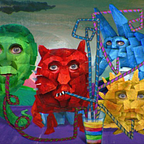Having only just commenced the ‘taiji (Tai Chi) journey’, I’m probably not best placed to offer much in the way of useful information on the intricacies of this ancient, yet still thriving ‘art-form’.
But speculate on general principals? Why, of course, i’d be delighted to!; There seems much here that resonates with the themes that have long been of interest to me.
Taiji appears to be fundamentally concerned with the building and control of ‘another body’; This is not just a turn of phrase, It refers to a ‘real’, tangible second body; a complement to our known physical body.
This is termed the ‘kesdjan body’, in Gurdjieffian terminology
The second body of man can grow. It can become more robust until it is even more substantial than the physical body and can have power over it. With that, it can develop its own intelligence. Gurdjieff insists that ‘real reason and vision’ are only possible in the second body. Our planetary body can only have ‘relative reason.’
It receives it’s nourishment from ‘air’ as opposed to our planetary body which is nourished by ‘food’.
Without conscious development it remains no more than a ghost or shadow and is only able to exist in the world of psychic energies at its lowest levels.J.G Bennet
Certain substances from ‘the air’ are assimilated ‘through the pores’ and also by breathing, and in turn used to ‘coat and perfect’ the ‘higher-being-body’. Gurdjieff, however, advised against breathing exercises, except with an experienced teacher, or in conjunction with specially designed Movements.
He taught his pupils a series of movements to be performed with attention, self observation and breath control, which he called ‘sacred temple dances’
He also described the means by which we can develop this first ‘higher-being-body’ and transform it into something more ‘substantial’; Namely by conscious labour and intentional (voluntary)suffering.
The three mainstay practices of ‘conscious labour’ he set out are self-observation, self-remembering and also active mentation and contemplation.
‘Intentional suffering’ brings to mind the chinese term ‘chi ku’, which can be translated as to ‘eat bitter’
I am also reminded of Jung’s work on alchemy:
Alchemy announced a source of knowledge, parallel if not equivalent to revelation, which yields a ‘bitter’ water by no means acceptable to our human judgement. It is harsh and bitter or like vinegar, for it is a bitter thing to accept the darkness and blackness of the ‘umbra solis’ and to pass through the valley of shadow. p63 Jung on Alchemy
Our world is one of duality and separation. This is the double edged sword. splitting and separation allows the arising of phenomena and the illusion of movement; things are able to happen. But there is suffering too. The opposites long to be together, yet they also repel. There is a friction and tension. This allows the possibility of what Gurdjieff terms ‘work’.
The alchemist’s endeavours to unite the opposites culminate in the ‘chymical marriage’. The supreme act of union in which the work reaches its consummation. After the hostility of the four elements has been overcome, there still remains the last and most formidable opposition, which the alchemist expressed very aptly as the relationship between male and female. We are inclined to think of this primarily as the power of love and attraction, which drives the two opposite poles together, forgetting that such a vehement attraction is needed only when an equally strong resistance keeps them apart. p158 Jung on Alchemy
The movement forms of Taiji appear to be a way to train the ‘second body’ to move and act independently. It (we) requires training because it is not ‘controlled’ in the same way that we move the physical body. The physical body needs to be ‘decluttered’, opened and cleared to make way for this other body.
The chinese call this ‘Fang Song’ ; Literally to release and liberate through loosening.
Tensions in the physical body, habits and addictions of the mind and complexes and archetypes from the unconscious are all shadows or reflections of the same ‘objective cause’, only across different scales.
The ‘second body’ has many different expressions of energy, which have been identified and cultivated by internal martial arts practitioners among others.
Probably the most eye-catching, at least to our physical senses, is the ‘Fa jin’ energy. Which is a strike from the ‘second body’ extending outside the physical body.
Carl Jung, coming from a slightly different angle, discusses unconscious projections and the fact that although they have not been assimilated by consciousness, (ie made conscious), it does not necessarily mean that they do not carry weight or have substance:
…. a projection is a very tangible thing, a sort of semi substantial thing which form a load as if it had real weight. It is exactly as the primitives understand it, a subtle body. Primitives — also the Tibetans and many other people- in as much as they are aware of such things at all, understand projections as sort of projectiles, and of course they play a role chiefly in their magic. Primitive sorcerers throw out such projectiles. p82 Jung on Alchemy
The most important energetic expression of the second body, at least from a developmental, ‘continuing the journey’ sort of standpoint seems to be ‘Ting jin’; This is the listening energy.
It corresponds to the sensing aspect of the second body, as opposed to it’s moving aspect ‘manifested’ in energies such as ‘fa jin’.
